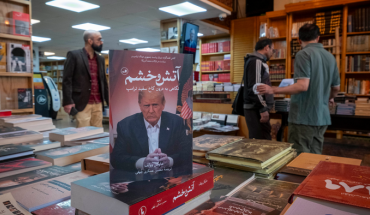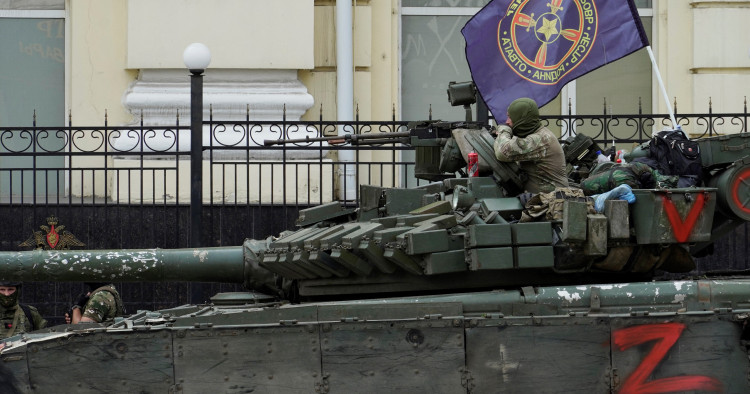The Wagner Group private military company’s rebellion against the Russian government, Ministry of Defense, and military leaders comes as no surprise, particularly amid the ongoing Russian-Ukrainian war. In recent months, Yevgeny Prigozhin, the chief figure behind these mercenary forces, has appeared repeatedly, criticizing and threatening Russian military leaders for what he claimed was a shortage of ammunition and equipment provided to his units on the Ukrainian front lines, especially in Bakhmut, which has caused the death of dozens of his fighters.
The conflict between the Wagner Group and the Russian government was not born out of the full-scale invasion of Ukraine, though the war there caused the rift to widen and tensions to explode publicly in the form of an armed rebellion. Instead, the discord actually started in Syria back in 2017 and has intensified since then, reaching its apogee a few weeks ago. The causes for the strife in Syria between Wagner and the Russian government came down to four issues.
The battles for Palmyra
The first source of the mutual dispute goes back to the first and second battles of Palmyra in late 2016 and early 2017, respectively. During these battles, Wagner forces, backed by the Syrian army, aimed to drive the Islamic State out of the ancient city. However, a major point of contention arose when the regular Russian military operating in Syria failed to adequately supply the Wagner Group with sufficient weapons for the mission. This led to delays and substantial casualties among Wagner units during their efforts to expel ISIS from the city.
In his recently published memoir, Russian writer Kirill Romanovsky delves into the intricacies of the rancor between the leader of Wagner and Gen. Alexander Dvornikov, who served as the commander of Russian forces in Syria at the time. Romanovsky, a correspondent for the RIA FAN news agency, which is associated with Prigozhin, was among the most prominent journalists following Wagner’s activities worldwide before he died from cancer last January. In the memoir, Romanovsky vividly depicts a scene on one of the hills surrounding the city of Palmyra. He portrays Prigozhin seated alongside Dvornikov as they observed the progress of the battle. It was during this encounter that several Wagner operatives lost their lives, and concerns were raised regarding the depletion of Wagner’s artillery ammunition. In the heat of the moment, the Wagner leader vehemently exclaimed, “Dvornikov, you scoundrel, give us 100 artillery shells!”
The dispute between the two parties during the battle of Palmyra deepened following the capture of the city in early March 2017. The Russian Ministry of Defense awarded medals to military leaders in the Russian Armed Forces and local Syrian militias for their courageous actions in the battle. However, Wagner forces, which played a leading role in the battle, were not granted any honors. Prigozhin frequently highlighted this discrepancy in his media appearances, characterizing it as an appropriation of Wagner’s efforts and sacrifices and their wrongful attribution to Russian military leaders.
Destruction of Wagner forces near Deir ez-Zor
The second source of conflict came in February 2018, when the Russian military command issued orders for Wagner forces to advance into the Khasham area, situated east of Deir ez-Zor. This area was under the control of the Syrian Democratic Forces (SDF) and the United States military. Wagner’s objective was to seize control of the Conoco natural gas plant, which held particular importance as Syria’s major gas facility. However, the group’s attempt to advance ended in a resounding failure. The international coalition forces, led by the U.S., conducted aerial and artillery strikes against the Wagner units. This resulted in the deaths of at least 200 fighters, with dozens more injured, along with the destruction of numerous military vehicles utilized by the private military company.
Prigozhin decided to proceed with the advance following assurances from Russian forces operating in Syria, resulting in Wagner’s successful capture of the Conoco field. Prigozhin was promised his ground forces would have comprehensive air protection, whether from the Russian Air Force or air-defense systems such as the S-300. Additionally, he was assured that he would be informed of any changes in plans made to address the American response. However, these pledges were not upheld, leaving the Wagner units vulnerable to American aircraft and artillery attacks. The incident subsequently became known in Russia as the “Red February Massacre.”
Wagner perceived the incident as a clear betrayal by the Russian Ministry of Defense, particularly in light of statements made by U.S. Secretary of Defense James Mattis during his testimony before Congress at the time. Mattis revealed that the Russians had disavowed any association with Wagner during direct communications between the two parties in the early stages of the Wagner forces’ advance into areas where U.S. troops were present. This denial left the U.S. military with no choice but to respond to the situation accordingly.
Following the incident, the Russian Ministry of Defense released statements asserting that the event was a reconnaissance and search operation conducted by Syrian forces without coordination with the Russian operational group’s command based in the village of al-Salihiyah. The ministry further claimed that there were no Russian soldiers present in that specific area of Deir ez-Zor Province, Syria.
Recruitment of Syrians to fight with Wagner in Libya
The third reason for the friction occurred in 2020 within the al-Hasakah Province, located in northeastern Syria. Wagner capitalized on the challenging economic conditions in the region, marked by a poor wheat harvest, a devalued Syrian currency, and a security crackdown enforced by the regime and the SDF, which included mandatory conscription. These circumstances prompted hundreds of young men from Arab tribes in the area to join Wagner’s ranks. Subsequently, they were transported to Libya to fight alongside Wagner forces in support of Libyan Gen. Khalifa Hifter’s campaign against the Tripoli-based government. These young recruits were transferred to eastern Libya under contracts primarily focused on protecting oil facilities.
This recruitment sparked an outcry from leaders and intellectuals of Syrian Arab tribes, who demanded that Russian forces intervene to stop tribal members from being turned into international mercenaries. Several tribes, including the Harb, Bani-Sabaa, Shurbayn, and Tay, issued statements calling for an immediate halt to the enlistment operations. After a few weeks, talks were held between tribal leaders and the Russian military leadership in Qamishli and Hmeimim. During these meetings, the discussions revolved around the necessity of ending recruitment operations to limit Wagner’s growing strength and cease its activities in the region, which were perceived as an attempt to create divisions among the tribes. Sign-ups were subsequently halted in the middle of the summer of 2020.
Tensions with Chechen forces
The fourth reason for the acrimony emerged in the aftermath of the early stages of the Russian re-invasion of Ukraine in 2022. Conflicts arose between Wagner and the Chechen battalion stationed near Qamishli Airport in Syria’s al-Hasakah Province, where Russian forces were operating. The disagreement stemmed from the Chechen battalion displaying pictures of Chechnya’s leader Ramzan Kadyrov and characterizing him as a hero of the Ukrainian war. In contrast, Wagner believed that its fighters were at the forefront of the battle and responsible for restoring the reputation of the Russian army following the failed attack on Kyiv. This difference in perspectives led to tensions and disputes between the two groups.
Additionally, the Chechen fighters prayed and worshiped together, which caused discomfort among the Wagner fighters and some Russian officers. Although these tensions continued to escalate, the Russian officer command tended to avoid clashes with the Chechen battalion, especially since the Russian forces in Qamishli included Muslim fighters from Dagestan. This tension resulted in a lack of cooperation between the two parties, with Wagner operating independently of Russian forces.
After Prigozhin’s failed putsch
The consequences of the Wagner military rebellion on June 23-24 soon began to manifest on Syrian soil, according to local authorities. Following the Wagner Group’s announcement of control over Rostov and its threat to advance toward Moscow, Russian military police and Russian forces in Syria, backed by Iranian militias, reportedly moved to encircle Wagner’s headquarters in eastern Syria, particularly in the countryside of Homs and Deir ez-Zor Province. Subsequently, they arrested all members affiliated with the Wagner militias. (It is worth noting that the above account of the fate of Wagner members directly contradicts earlier reported denials, coming out of sources in Moscow and Syria, that such crackdowns took place.)
These operations resulted in clashes between the Russian military police and Wagner members in the city of Mayadin, in Deir ez-Zor, leading to the death of three Russian military police personnel. The detained Wagner members were subsequently transferred to the Hmeimim military base, while the Russian military police handed over former Wagner materiel and facilities in those areas to Iranian militias. This occurred amid talks about Iranian attempts to attract Syrian fighters who were loyal to Wagner in the countryside of Homs, due to their combat experience, and efforts to transfer them to Iranian militia headquarters in Deir ez-Zor and Hasakah.
Conclusion
Wagner has played a significant role in safeguarding Russian interests in Syria and supporting the Bashar al-Assad regime in its efforts to solidify control over various regions of the country. In return, Wagner secured investment contracts and substantial financial commitments from the Assad regime, particularly in the oil and gas sectors. The future of these investments and contracts, as well as the question of who will succeed Wagner in Syria, remains uncertain.
Furthermore, it is important to consider whether we may witness a recurrence of militia rebellions against state institutions, similar to those carried out by Wagner in Russia or the Rapid Support Forces in Sudan. This question is particularly relevant given the prolonged duration of the Syrian war, which has compelled the Assad regime to rely on numerous local and cross-border militias with distinct personal and economic interests separate from those of the Syrian Ministry of Defense and regular army command.
Samer al-Ahmed is a Syrian journalist and researcher who focuses on developments in northeastern Syria. He is a master’s student in international relations and has written multiple reports and research papers for Arab and international centers. You can follow him on Twitter @sameralahmadnq.
Mohammed Hassan is a Non-Resident Scholar with MEI’s Syria Program and a master’s student in the Department of International Relations at the Higher School of Journalism in Paris. His writings focus on the regions of northern and eastern Syria, especially extremist Islamic groups and tribal societies.
Photo by STRINGER/AFP via Getty Images
The Middle East Institute (MEI) is an independent, non-partisan, non-for-profit, educational organization. It does not engage in advocacy and its scholars’ opinions are their own. MEI welcomes financial donations, but retains sole editorial control over its work and its publications reflect only the authors’ views. For a listing of MEI donors, please click here.













